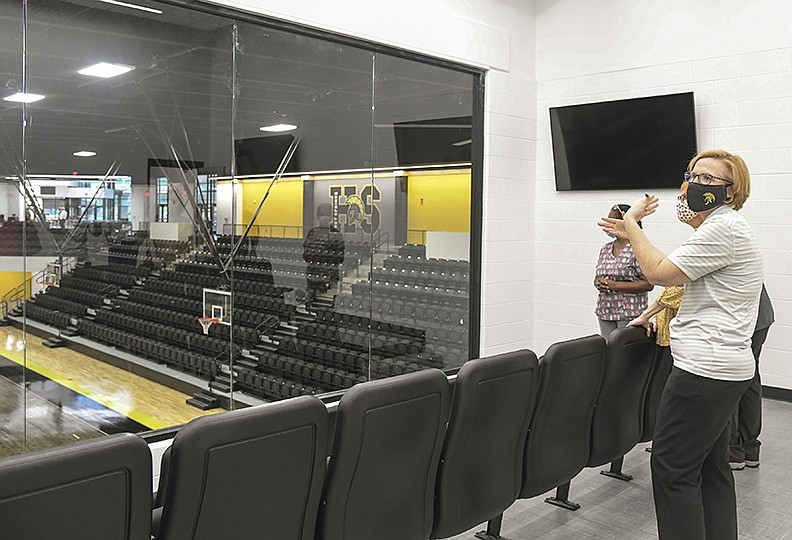The month of March marks one year since schools in Garland County had to pivot to virtual learning due to the COVID-19 pandemic.
Brian Bridges, Lake Hamilton School District communications and public relations coordinator, said the district has learned a lot about virtual learning since the pandemic first swept Arkansas last spring, noting the sudden shift to virtual classes was something schools were not prepared for.
"That said, as soon as schools were mandated to pivot to virtual learning, our staff responded with inspired attitudes and tremendously innovative plans for virtual learning to ensure our students would continue to have a guaranteed and viable curriculum," he said.
Video not playing? Click here https://www.youtube.com/embed/YaqNtpT4FUU
John Hogan, National Park College president, said the college has done remarkably well in adapting to virtual learning.
"Our faculty were previously trained, and our investments in infrastructure helped us significantly," he said.
"We did have to add some hardware in the classrooms," Hogan said.
"We navigated it much better than a lot from March to May; felt like we had a really good technology plan. Our technology staff worked really hard to get devices out to all of our kids and get the coverage, the internet access; we worked real hard to close that gap," Lakeside Assistant Superintendent Bruce Orr said.
"I think when we had to transition to virtual learning back in March of 2020, I don't think anybody was totally prepared," Hot Springs Superintendent Stephanie Nehus said.
"I think we were all in crisis mode at that point in time. I can definitely say in the beginning of August, when we had that virtual option; we were totally prepared for that," she said.
Some of the challenges the surrounding schools have had to face while moving to virtual learning included teachers having to convert lessons designed for in-person environments to an online environment.
"I think our biggest challenge a year ago was just the unknown. We didn't know how long we would have to switch to virtual; we didn't know what was going to happen with the pandemic. We didn't know how many people had internet access," Nehus said.
"There were so many things that were just unknown. I think that we were able to communicate well with all of our stakeholders, our families, our students, our teachers. I think that communication helped us move forward over time," she said.
Cutter Morning Star Superintendent Nancy Anderson said the district was not completely prepared, such as making sure all students had internet at home and that they could access materials.
"We were very blessed at Cutter to be somewhat prepared because we're a one-to-one district, meaning that before the pandemic, every student on campus had a device," she said.
Jessieville Superintendent Melissa Speers said one thing they are still struggling with is areas in the district that have no cellphone service, which means no internet service.
"I consulted with a company and had them come in and look at our districts early last summer. I was going to invest some money and put in some towers throughout our district, but then when we looked at the expense, it was going to cost over a million dollars," she said.
"We were going to have to go to each home and install hardware, and it just was not feasible. Until the state of Arkansas addresses the broadband issue in rural areas, we're always going to have issues with virtual learning," Speers said.
Virtual learning has been a struggle, but some students and teachers have adapted better than others.
"We were trying to reduce the number of students in each classroom, so we kind of went with a hybrid approach where we had virtual and on-site in the same classroom because we wanted to kind of go with the safety standpoint of it, so this year has been very difficult on our staff," Orr said.
Over time, the challenges the schools have faced have lessened.
"Our students surprised me with their grit and willingness to persist under unpredictable circumstances," Hogan said. "We should be proud of this generation of learners who exemplifies Nighthawk grit. What they endured will pay dividends for them."
"Our teachers and students now have had and continue to receive lots of training opportunities for virtual learning best practices, all of our students have their own electronic device assigned to them, and we have been able to provide internet opportunities for students," Bridges said.
Some of the schools are still in the planning process when it comes to keeping the practices they have learned over the year, such as online learning.
"What will be the 2021-2022 school year, we're going to offer on-site instruction K through 12. There will be some of the precautions that we use this year that we feel enhances student safety structure within the school day, anything that we found that were very complimentary to learning; we're going to continue to maintain those elements," Fountain Lake Superintendent Michael Murphy said.
"We went into this thing, kind of blind, and we came out learning a lot about blended learning and virtual learning," Mountain Pine Superintendent Bobby Applegate said. "We've kind of made a good transition to it, and our students adjusted pretty well to it."
"We're starting to see a lot more light. I feel like we're seeing the light at the end of the tunnel," Orr said.
